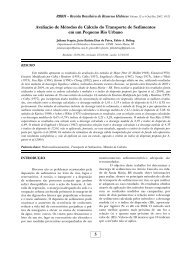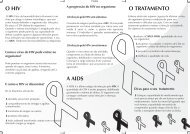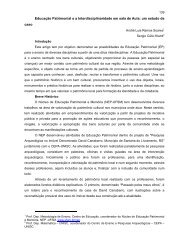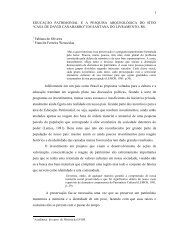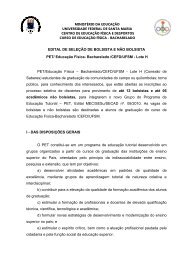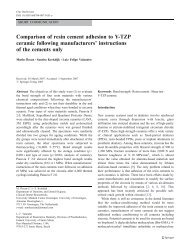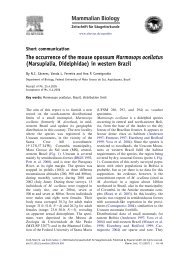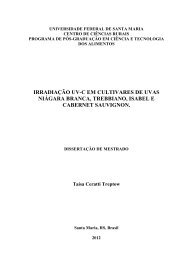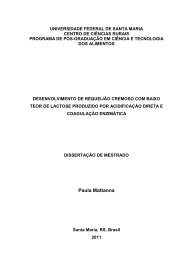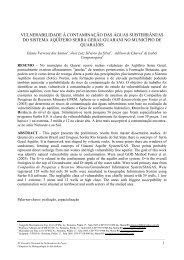DESENVOLVIMENTO E CARACTERIZAÇÃO FÃSICO ... - UFSM
DESENVOLVIMENTO E CARACTERIZAÇÃO FÃSICO ... - UFSM
DESENVOLVIMENTO E CARACTERIZAÇÃO FÃSICO ... - UFSM
You also want an ePaper? Increase the reach of your titles
YUMPU automatically turns print PDFs into web optimized ePapers that Google loves.
54<br />
1 INTRODUCTION<br />
In the past a few years, many authors have been largely used different fruits for the<br />
production of wine. Its volatile composition has been used as a source for the study of the most<br />
variety extraction techniques, pathways involved into volatile formation and aroma potential.<br />
(SOUFLEROS et al., 2001; GARRUTI et al., 2006; DUARTE et al., 2009; PINO & QUERIS,<br />
2010; PINO & QUERIS, 2011a; DUARTE et al., 2010a; DUARTE et al., 2010b; PINO &<br />
QUERIS, 2011b; BERNARDI et al., 2013). The development of fruit wines emerges as one<br />
possible use for the abundance of native and tropical fruits existent in many parts of the world,<br />
such as, Brazil. Fermented beverages fruit products are a promising trend due acceptance in<br />
consumer research and contribution to the reduction of post-harvest losses of perishable fruits<br />
(DUARTE et al., 2010a).<br />
Further that, fruits are known to possess a complex volatile composition (FERRÃO, 2012;<br />
BICAS et al., 2011), which may give origin to beverages with different aromas than those that<br />
already exist on the market. As well known, the wine aroma is formed by hundreds of volatile<br />
compounds including higher alcohols, aldehydes, ketones, esters, acids, monoterpenes and C13-<br />
norisoprenoids (SANCHEZ-PALOMO et al., 2007). The origin of these compounds in wine may<br />
differ and can vary in accordance with many factors like, the composition of the raw material, the<br />
fermentative process applied and also from different chemical reactions that occur in wine during<br />
fermentation (PEREZ-PIETRO et al., 2003; MOLINA, SWIEGERS & VARELA, 2007). The<br />
compounds that define wine aroma are related to acceptance or rejection of wines by the consumers,<br />
that’s why the fermentation parameters that may influence the aroma have been extensively<br />
researched by many authors (CABAROGLU et al., 1997; DARIAS-MARTÍN et al., 2003; SELLI<br />
et al., 2006; SANCHEZ-PALOMO et al., 2007; RADEKA et al., 2007). However, for fruit wines<br />
most the existing studies are focused in yeast selection and different fruit cultivars as quality<br />
parameters to the wine aroma. Le et al., (2012) analyzed the behavior and fermentation<br />
performance of mixed yeasts in mango juices of three varieties and Duarte et al., (2010) reported<br />
the yeast selection for raspberry wine and Dias et al., (2007) for cocoa wine. Although the yeast<br />
strain is one of the most important parameters of fermentation, the time that wine will remain in<br />
contact with the skins or the pulp and furthermore, the temperature that will be employed for<br />
fermentation also interfere significantly in the aroma of the final beverage. Jelly palm fruit has been



